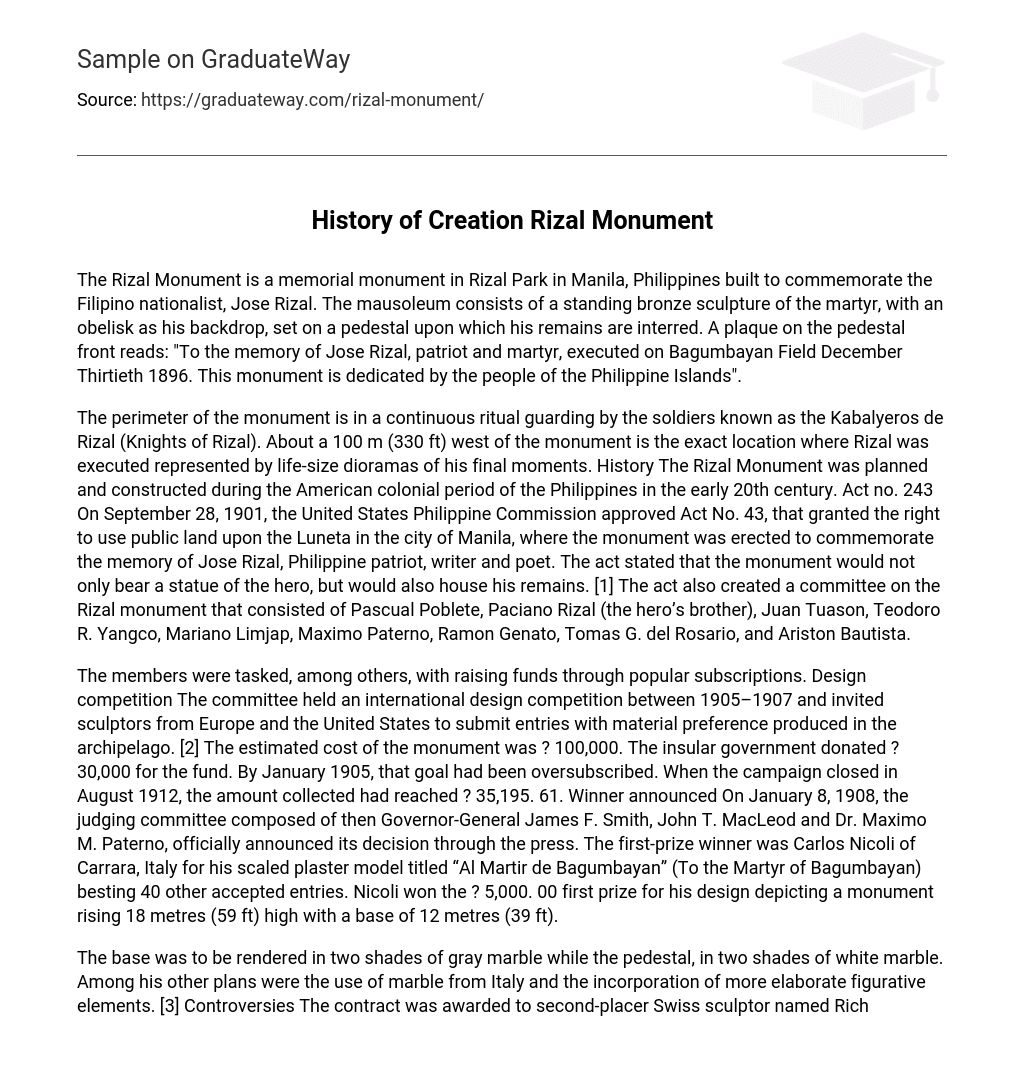The Rizal Monument is a memorial monument in Rizal Park in Manila, Philippines built to commemorate the Filipino nationalist, Jose Rizal. The mausoleum consists of a standing bronze sculpture of the martyr, with an obelisk as his backdrop, set on a pedestal upon which his remains are interred. A plaque on the pedestal front reads: “To the memory of Jose Rizal, patriot and martyr, executed on Bagumbayan Field December Thirtieth 1896. This monument is dedicated by the people of the Philippine Islands”.
The perimeter of the monument is in a continuous ritual guarding by the soldiers known as the Kabalyeros de Rizal (Knights of Rizal). About a 100 m (330 ft) west of the monument is the exact location where Rizal was executed represented by life-size dioramas of his final moments. History The Rizal Monument was planned and constructed during the American colonial period of the Philippines in the early 20th century. Act no. 243 On September 28, 1901, the United States Philippine Commission approved Act No. 43, that granted the right to use public land upon the Luneta in the city of Manila, where the monument was erected to commemorate the memory of Jose Rizal, Philippine patriot, writer and poet. The act stated that the monument would not only bear a statue of the hero, but would also house his remains. [1] The act also created a committee on the Rizal monument that consisted of Pascual Poblete, Paciano Rizal (the hero’s brother), Juan Tuason, Teodoro R. Yangco, Mariano Limjap, Maximo Paterno, Ramon Genato, Tomas G. del Rosario, and Ariston Bautista.
The members were tasked, among others, with raising funds through popular subscriptions. Design competition The committee held an international design competition between 1905–1907 and invited sculptors from Europe and the United States to submit entries with material preference produced in the archipelago. [2] The estimated cost of the monument was ? 100,000. The insular government donated ? 30,000 for the fund. By January 1905, that goal had been oversubscribed. When the campaign closed in August 1912, the amount collected had reached ? 35,195. 61. Winner announced On January 8, 1908, the judging committee composed of then Governor-General James F. Smith, John T. MacLeod and Dr. Maximo M. Paterno, officially announced its decision through the press. The first-prize winner was Carlos Nicoli of Carrara, Italy for his scaled plaster model titled “Al Martir de Bagumbayan” (To the Martyr of Bagumbayan) besting 40 other accepted entries. Nicoli won the ? 5,000. 00 first prize for his design depicting a monument rising 18 metres (59 ft) high with a base of 12 metres (39 ft).
The base was to be rendered in two shades of gray marble while the pedestal, in two shades of white marble. Among his other plans were the use of marble from Italy and the incorporation of more elaborate figurative elements. [3] Controversies The contract was awarded to second-placer Swiss sculptor named Richard Kissling for his “Motto Stella” (Guiding Star). Many accounts explained why the contract landed to Kissling, one is Nicoli’s inability to post the required performance bond of P20,000 for the duration of the monument’s construction.
Some sources say that Nicoli failed to show up at the designated date for the signing of the job contract. Another narrative declared Kissling’s quotation was lower than that of Prof. Nicoli’s. A complaint was reportedly filed by Nicoli through the courts of justice. Back view of the monument Some of the local press lambasted Kissling’s model. It was satirized in a cartoon and labeled vulgar y tosco, meaning “lousy. ” The constituents of the Jury of Awards – none of whom were artists, architects nor engineers – were also questioned.
There were plans for the famous Filipino painter Felix Resurreccion Hidalgo to inspect and modify the design. However, the latter was ultimately left “as it is” since the bronze of the statues had already been cast in Switzerland. Dedication More than twelve years after the Philippine Commissions approval of the Act, the shrine was finally unveiled on December 30, 1913 during Rizal’s 17th death anniversary. His poem, now popularly known as “Mi Ultimo Adios” (“My Last Farewell”) is inscribed on the memorial plaque. WWII Philippine banknote with Rizal Monument
World War II During World War II in 1943, the Japanese government issued ‘invasion money’ to occupied territories in the Pacific area of operations, one of which was the Philippines. Out of three series, the second was issued in 1, 5, 10, and 100 Peso only. All have the Rizal monument vignette on the banknote. Steel pylon The steel pylon that temporarily surmounted the monument. In Rizal’s birth centenary year of 1961, a stainless steel pylon was superimposed over the granite obelisk, increasing the structure’s height from 12. 7 meters to 30. 5 meters.
The remodeling undertaken by the Jose Rizal National Centennial Commission (JRNCC) was widely criticized. Many found the gleaming modern steel shaft incompatible with the somber granite base. Moreover, the latter seemed to dwarf the much smaller Rizal figure. Others simply dislike the idea of tampering with a popular and traditional image. The designer of the remodeling was Juan Nakpil, who later became the country’s first National Artist for Architecture. He quoted former Secretary of Education and JRNCC chair Manuel Lim as envisioning the pylon as a convenient guide for incoming boats, and for the people lost in their way around the city.
The P145,000 shaft was removed two years later under the request of Secretary of Education Alejandro Roces and Director of Public Libraries Carlos Quirino. It was dismantled during Holy Week, reportedly to prevent any court injunction from restraining them as government offices were closed during holidays. The pylon is now located at the median of the Baclaran section of Roxas Boulevard. Management Close-up of the monument plaque Rizal Monument, as well as Rizal Park, is administered by the National Parks Development Committee, an attached agency of the Department of Tourism. [4]





